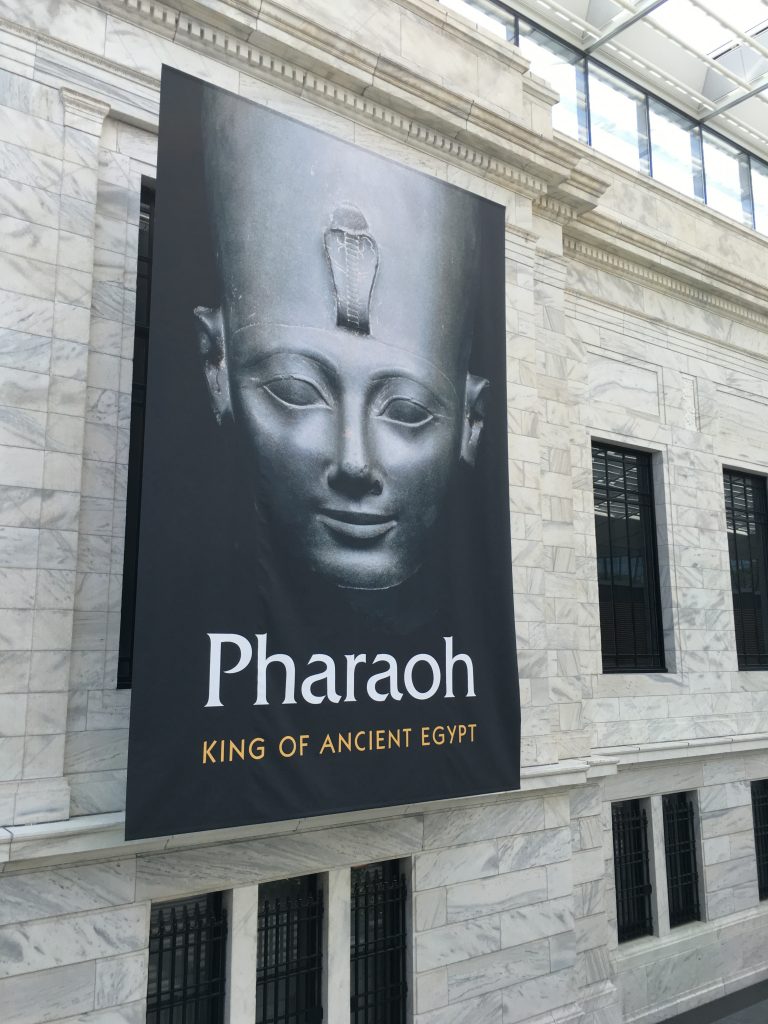
Entering the Cleveland Museum of Art, I was overwhelmed with excitement to view the new exhibit: Pharaoh, King of Ancient Egypt. For months, I had been eager to explore this amazing showcase with over 200 ancient artifacts on loan from the British Museum. This exhibit provided an in-depth insight into the life, customs and culture of the Egyptian Pharaohs who ruled from 3000 BC to 30 BC.
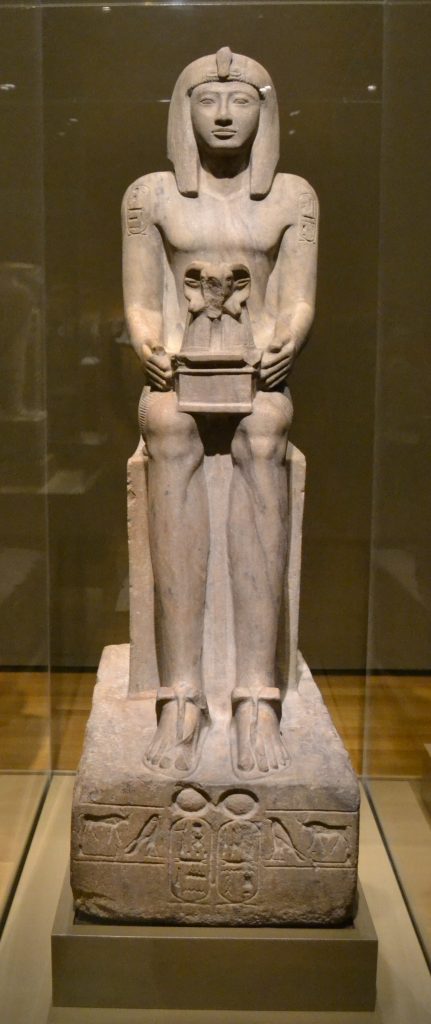
The ancient Egyptians worshiped hundreds of gods and goddesses. The pharaoh was not only the ruler of the Egyptian kingdom but a religious figure as well. According to their beliefs, the pharaoh, an earthly representation of the god Horus, took human form to keep order within the kingdom of Egypt and to protect its citizens. Through various rituals, the pharaoh would attempt to please the gods in hopes to grow abundant crops and defeat their enemies. This was displayed by the 5-foot statue of Seti II seated on his throne while making an offering to the god, Amun, symbolized by a ram’s head on the shrine that Seti is holding. At the base of the statue is the carved name of Seti II, known in Egypt as a cartouche.
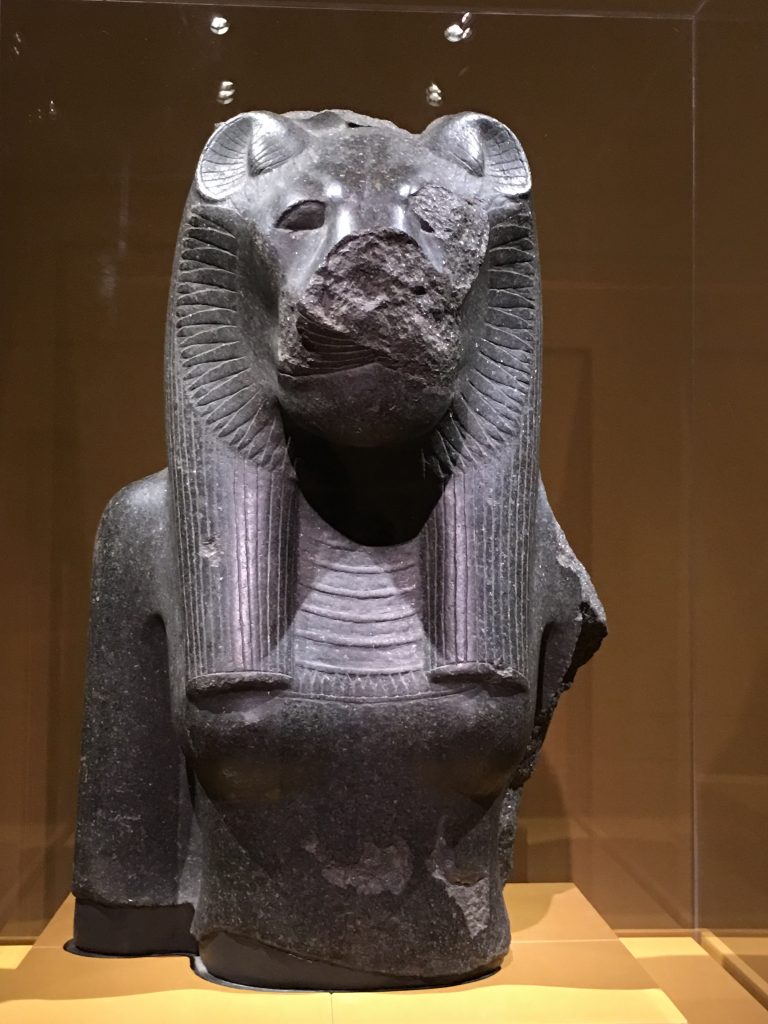
Once the pharaoh died, the Egyptians believed that he (or she) would be transformed as the god Osiris, the ruler of the underworld. Within his tomb, offerings of bread, wine and carved figures were given as gifts to the gods. The goddess Sekhmet was considered the “daughter of Ra”, a very powerful god, associated with the sun. She could also transform herself into the uraeus, the rearing cobra, displayed on the crown of the pharaohs.
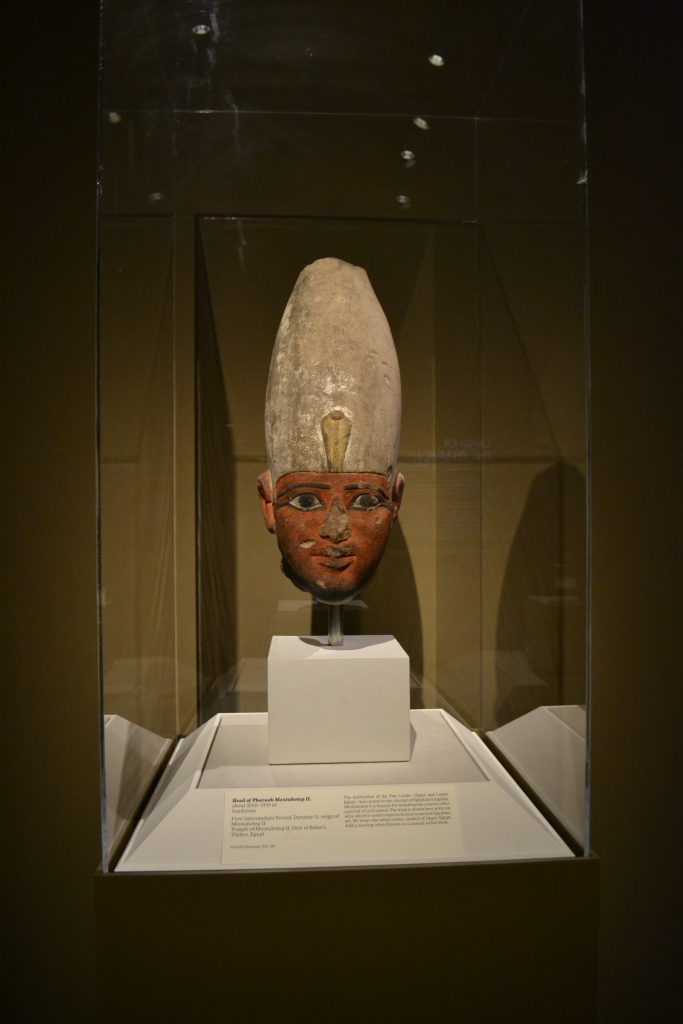
One exhibit showed the Head of Pharaoh Mentuhotep II, a perfect example of the uraeus. His white crown symbolized the rule of the land of Upper Egypt while a red crown represented the rule of Lower Egypt. When the kingdoms were combined, the crown included both symbols of Upper and Lower Egypt.
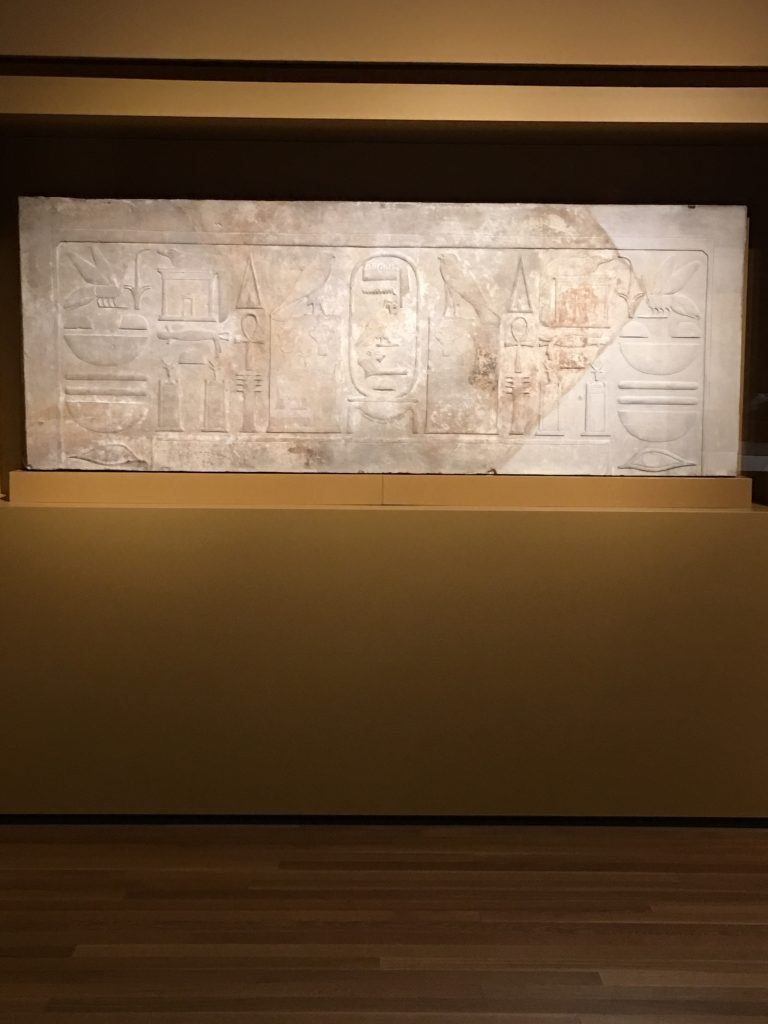
In addition to statues, figures were also carved into the lintels of Egypt’s extravagant temples. The new pharaoh would leave his mark by building his own temple where the writing on the lintel would reference his rule. The lintel of Amenemhat III is a fine example of what would have been built in the time period of 1859 BC to 1814 BC.
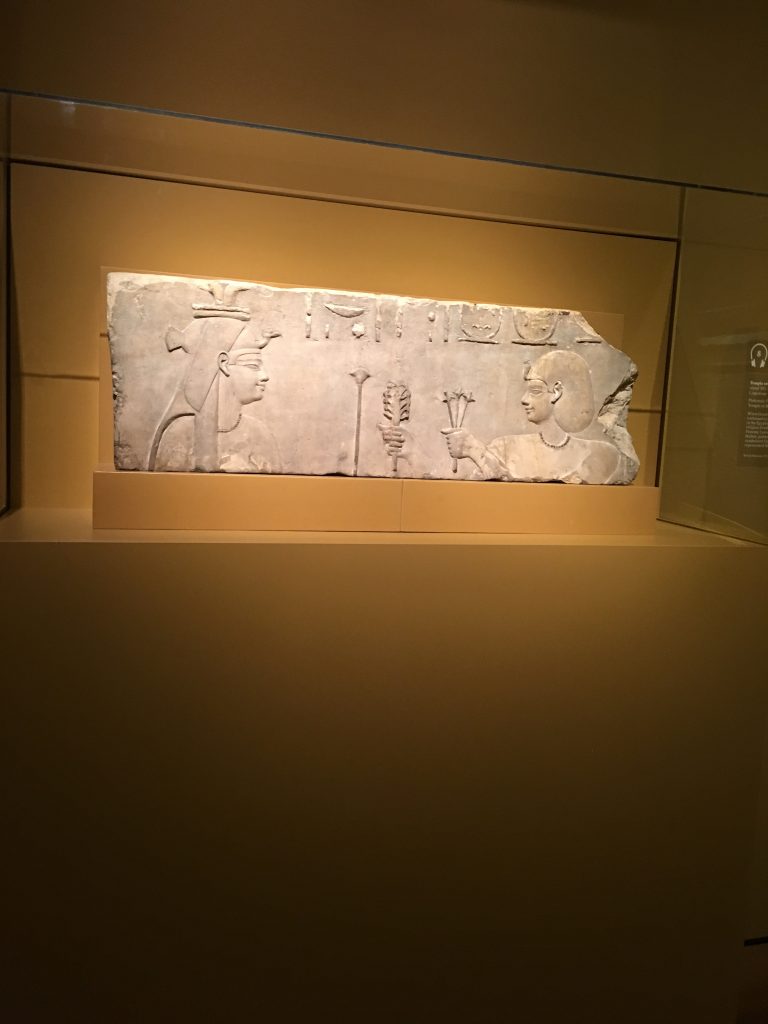
During the Ptolemaic Period, when Greeks ruled Egypt, the tradition of building temples in the Egyptian style continued. According to the exhibit placard, it reads, “Pharaoh Ptolemy I presents grass and a papyrus plant to Hathor, goddess of fertility and joy. These plants symbolized Upper and Lower Egypt; together they represented the unification of the Two Lands.”
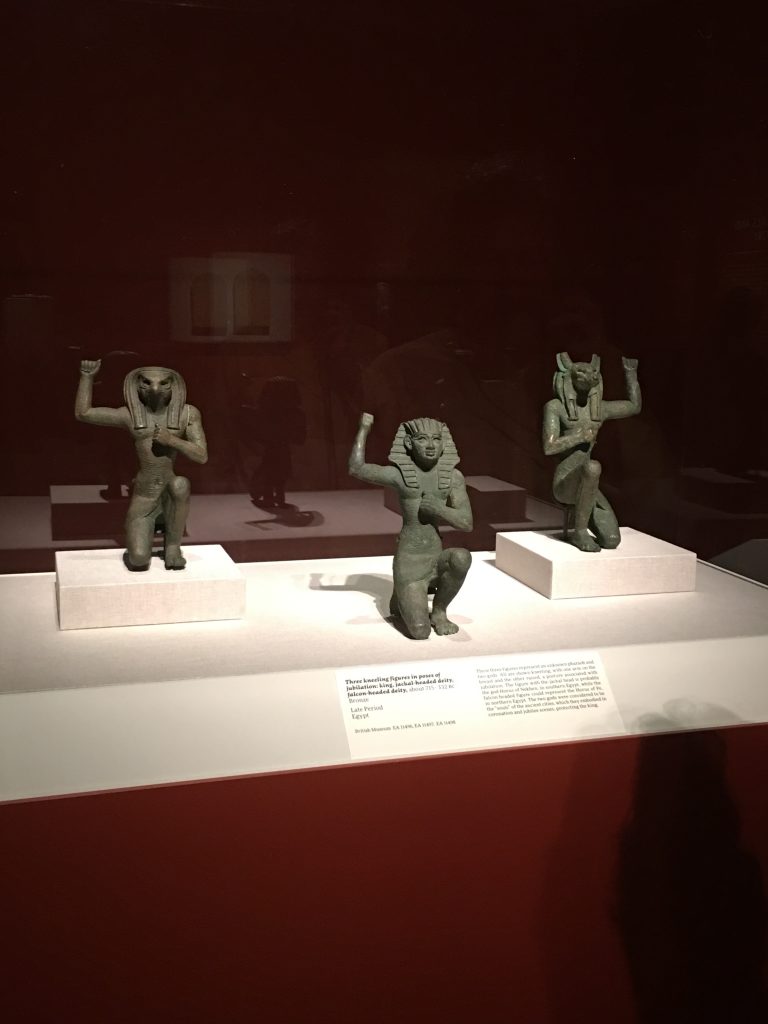
Smaller figurines of the pharaoh and the gods were also carved out of stone or wood while some were sculpted out of bronze. The jackal head is thought to have represented the god Horus in southern Egypt while the falcon may have been associated with the Horus of Pe in northern Egypt.
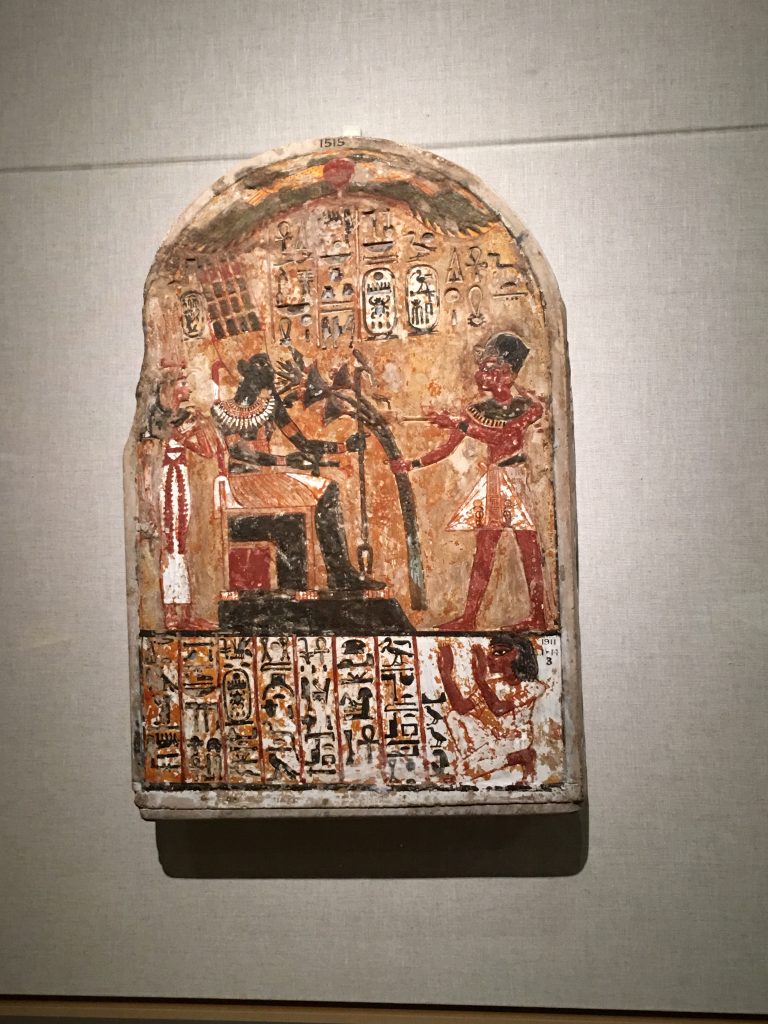
The colorful stela (writing on stone) of Pharaoh Tuthosis IV showed his offering a gift of papyrus and lotus flowers to Amun-Ra and the deified queen Ahmose-Nefertari, who was the wife of Pharaoh Ahmose. It is believed to have been created somewhere between 1279 BC – 1203 BC by Kha, the man who is carved into the bottom with his arms raised.
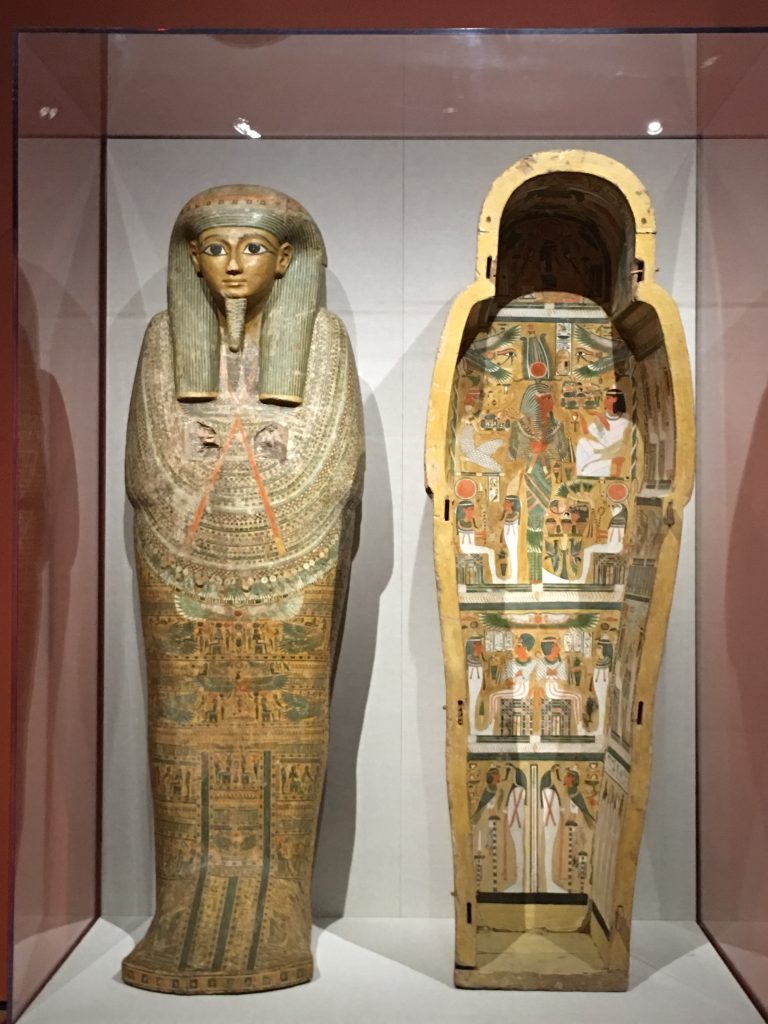
One of my favorite items in the exhibit was the Coffin Case of Bakenmut. I was taken by surprise at the beautiful artwork displayed both inside and out. Although not the sarcophagus of a pharaoh, it was the resting place of a member of the clergy of Amun at Thebes, a very rich man. It is estimated that it was built between 950 BC – 900 BC and made out of sycamore wood.
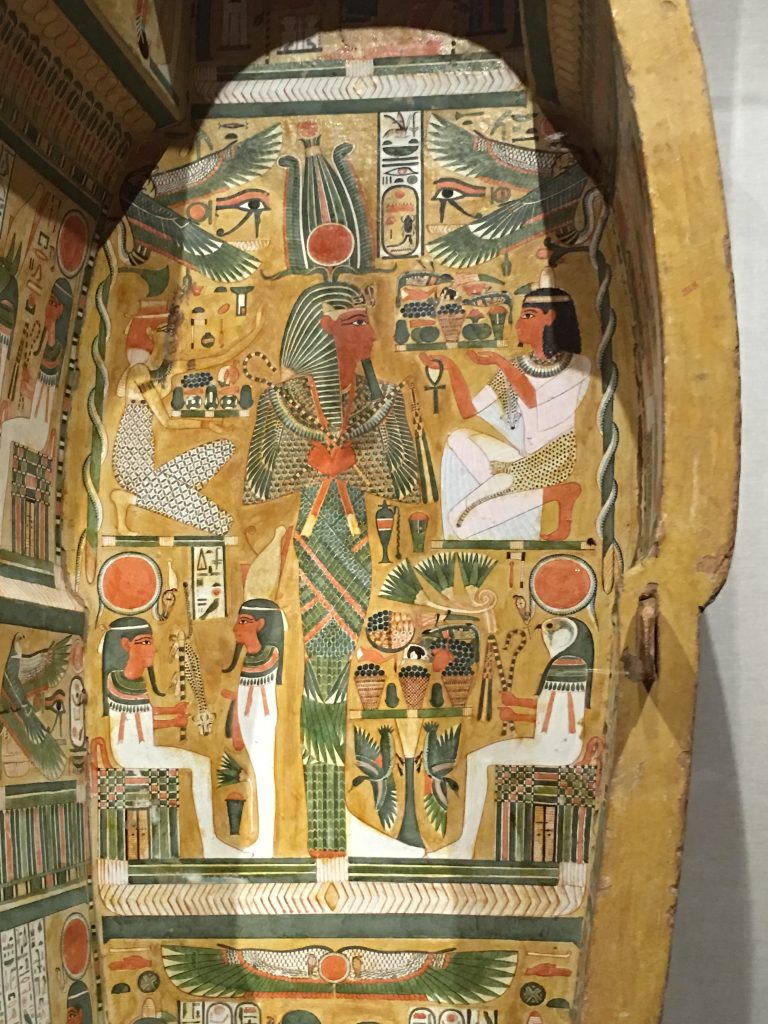
On the interior, there are images of two deified kings, Amenhotep I and Tuthmosis III from Dynasty 18. It is believed that Bakenmut desired to have an association with these kings in the afterlife.
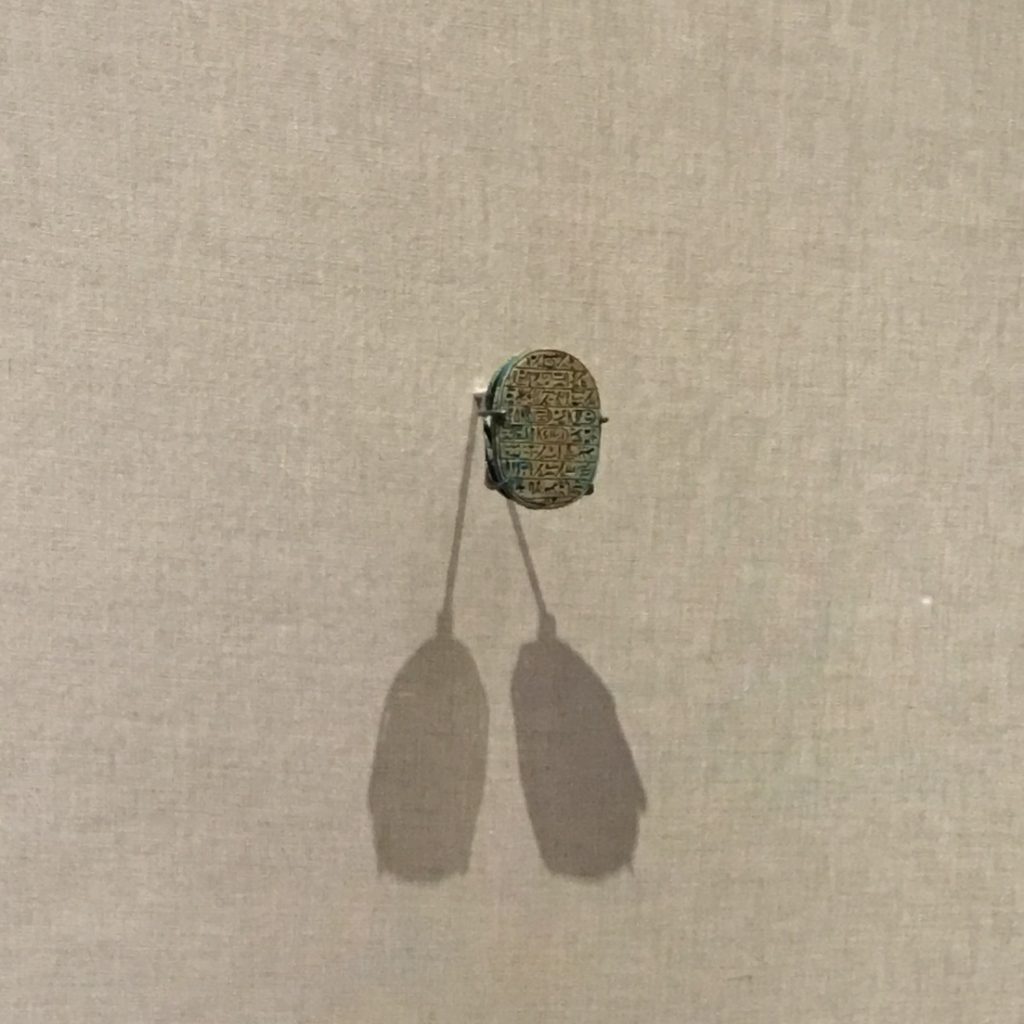
I also enjoyed the wing of the exhibit that documented the lives of the royal family. Various everyday items displayed included jewelry as well as tiles and reliefs that decorated their opulent living spaces. One of my favorite pieces was the scarab beetle that dated back between 1391 BC to 1353 BC. The scarab symbolized immortality, resurrection, transformation and protection and most used to decorate tombs.
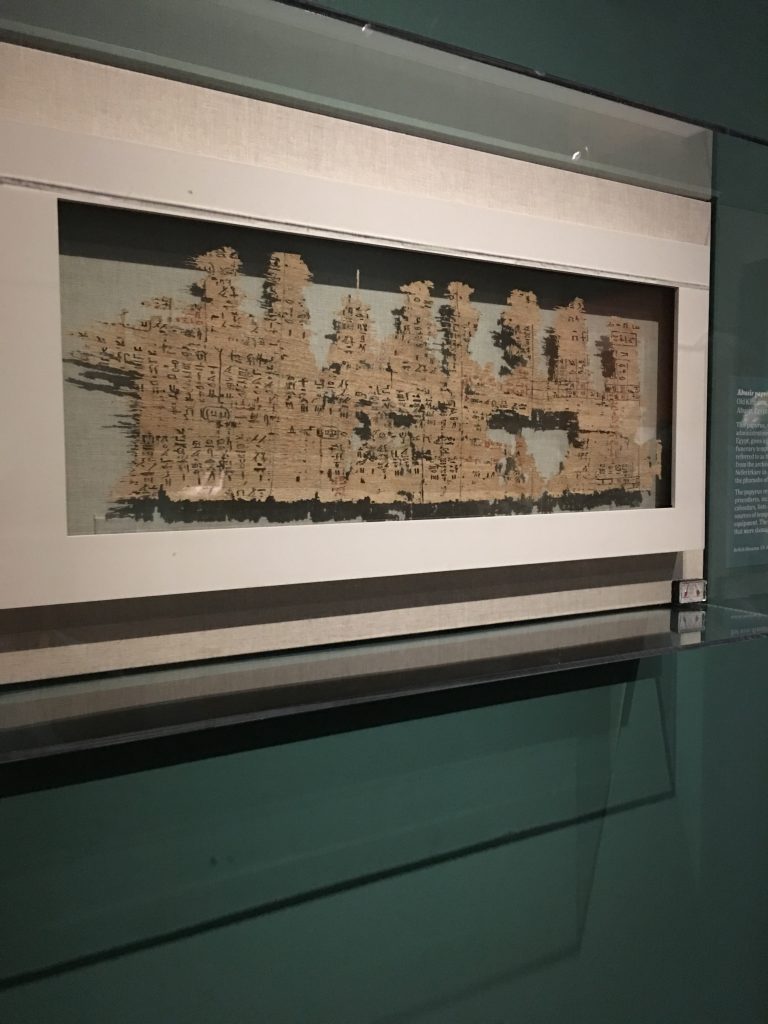
One of the most fascinating artifacts in the collection was the papyrus that dated back to 2454 BC – 2311 BC. This document revealed the administrative functions and economic procedures of that time period. For example, lists of offerings, calendars, accounts and inventory have been found by archaeologists and researchers.
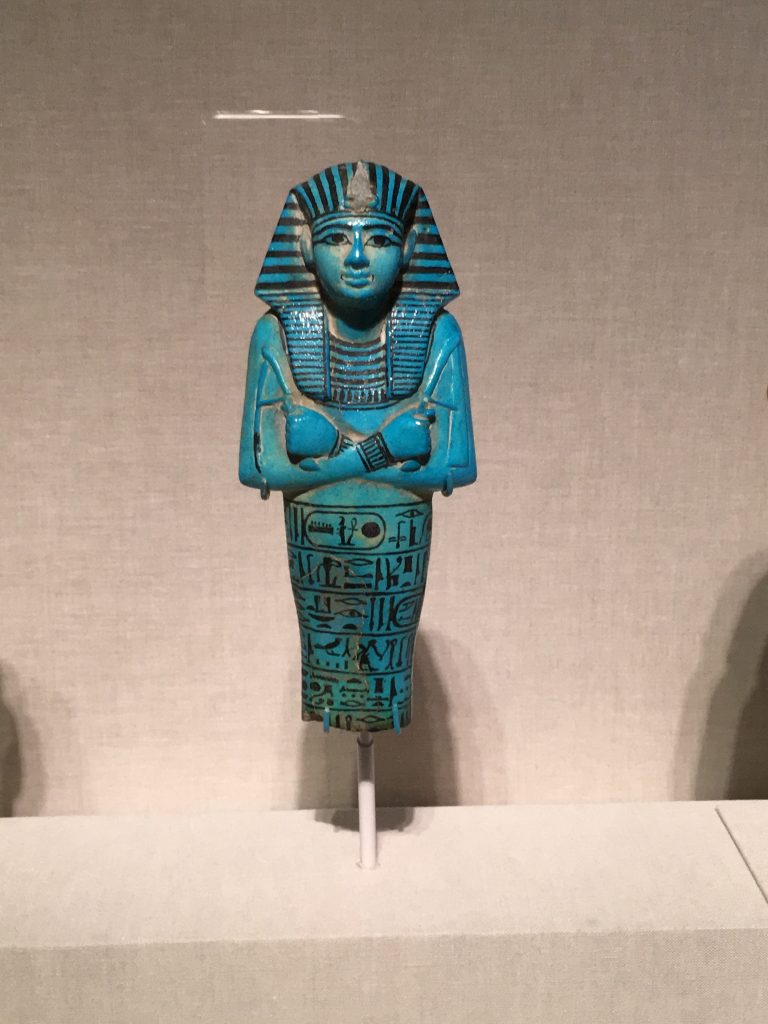
When the pharaoh died elaborate tombs were designed to assist him with his passing and provided him with the items he would need in the afterlife. For example, many valuable objects would be buried with the pharaoh such as furniture, food and jewels. One of the most interesting objects was the shabti, a funerary figurine that was said to act as a servant for the deceased, carrying out manual labor after the pharaoh’s death. The turquoise Shabti of Seti I was said to have been carved from 1294 to 1279 BC.
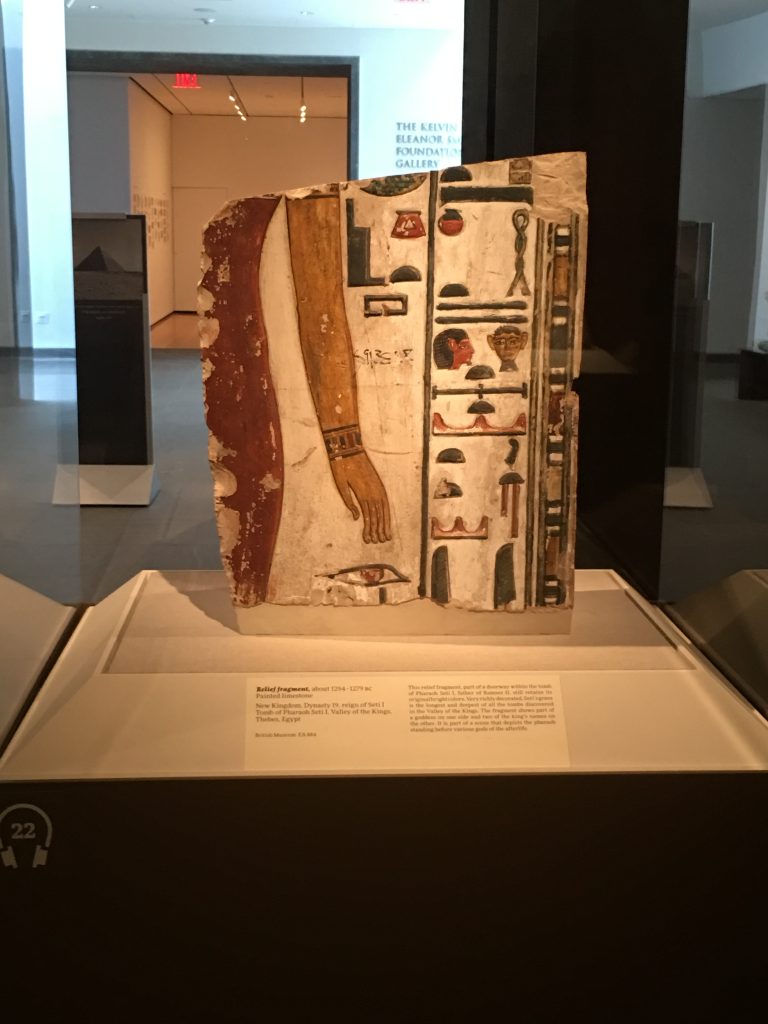
Inside of the tomb, reliefs were painted to show images of the pharaoh in the afterlife. Seti I was the father of Ramses II and his tomb was considered the longest and deepest of all tombs discovered in the Valley of the Kings in Thebes. The fragment from his tomb has retained its original color and was part of the doorway .
The pharaoh lived a life of luxury not only on earth, but beyond his death. Valuable artifacts that were once the property of the pharaohs show the extravagant lifestyle for which they were accustomed. While many of us believe “you can’t take it with you”, the Egyptians would vehemently disagree.
The Pharaohs exhibit at The Cleveland Museum of Art was an insightful opportunity to explore the lives of the Egyptian pharaohs and to witness firsthand their riches and culture. The exhibit was on loan from the British Museum and was open to the public from March 13th to June 12th, 2016.
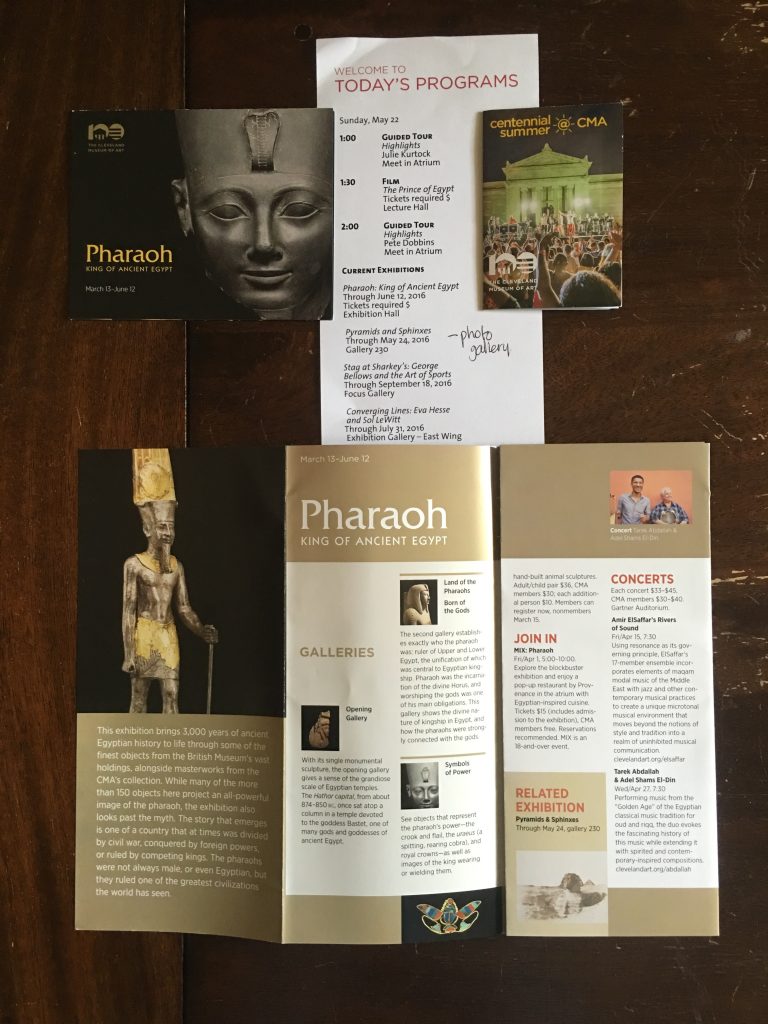
Have you had the opportunity to visit the Cleveland Museum of Art? What was you favorite exhibit? I would love to hear from you if you would kindly leave a message in the comments section below. Many Thanks and Happy Travels!
What to See and What to Do:
Cleveland Museum of Art
11150 East Boulevard
Cleveland, OH 44106
Telephone: 216 421 7350
- Admission Fee: Free for the permanent museum exhibits. Additional fees may apply for special exhibits and tickets can be purchased online, at the ticket center or by calling 216 421 7350.
- Hours: Open Tuesdays, Thursdays, Saturdays and Sundays from 10AM to 5PM; Open on Mondays and Wednesdays from 10AM to 9PM. Closed Mondays. Closed on the following holidays: New Year’s Day, Independence Day, Thanksgiving, and Christmas. The museum will close at 4PM on Christmas Eve and New Year’s Eve.
- Amenities: On-site library and archives, restaurant, café, and museum store
- Length of Visit: At least 3 hours for the permanent exhibit
- Tips for Your Visit: Ensure that you have visited the museum’s website to confirm additional exhibits.
Where to Stay:
Glidden House at University Circle
1901 Ford Drive
Cleveland, OH 44106
Telephone: 216 231 8900
The Glidden House is a gorgeous boutique hotel built in 1910. Located in a prestigious residential neighborhood of Cleveland, this extraordinary French Gothic offers impressive amenities and services.
Where to Eat:
Trentina Restaurant at Glidden House
1903 Ford Drive
Cleveland, OH 44106
Telephone: 216.421.2900
Trentina is the sixth restaurant of Jonathan Sawyer, a James Beard Award winning chef offering Northern Italian cuisine and wine.
Check out more of these phenomenal artifacts from the Cleveland Museum of Art’s exhibit Pharaoh: King of Ancient Egypt! Enjoy!
What to Read:
- Await Your Reply by Dan Chaon
- The Bluest Eye by Toni Morrison
- Cherry by Nico Walker
- The Coming of Fabrizze by Raymond DeCapite
- Derelict Paradise, by Daniel Kerr
- The End by Salvatore Scibona
- A Ghetto Takes Shape: Black Cleveland, by Kenneth L. Kusmer
- The Greatest Thing Since Sliced Bread, by Don Robertson
- The Headmaster’s Papers, by Richard Hawley
- The Silent Syndicate, by Hank Messick
- The Sparrow, by Mary Doria Russell
Photo Guide for Cleveland:
- Abbey Road Skyline
- Brewnuts is not only a lovely donut shop, but its nostalgic art deco interior is perfect for unique photos
- A Christmas Story House in nearby Tremont
- Civic Center District to photograph Cleveland’s City Hall, Rock and Roll Hall of Fame and FirstEnergy Football Field
- The Cleveland Arcade is one of the most photographed location in Cleveland so arrive early (8 or 9) before the crowds arrive.
- Cleveland MetroParks Zoo
- Cleveland Murals in Ohio City (close by)
- Cleveland’s Museum of Art for its phenomenal architecture and exhibits
- Cleveland Public Library
- Cleveland Signs
- Coastal Taco has some of the best views of the river in the city of Cleveland.
- The Cuyahoga Valley National Park in Brecksville is for nature lovers.
- The Flying Fig is a yummy cafe where outdoor photos are a must.
- East Fourth Street is where you will find cozy cafes lining brick walkways
- The Fountain of Eternal Life honors local residents who served in the military (photograph during the day AND night)
- Great Lakes Brewing Company
- Heinen’s Grocery Store to photograph the rotunda overlooking the food court and check out the terrace for additional photos
- Holden Arboretum in nearby Kirtland
- Lakeview Cemetery
- Hope Memorial Bridge is the best place for photographing a cityscape photo of Cleveland
- Located at Playhouse Square, Yours Truly is a chic cafe with exposed brick and stylish furniture and the infamous GE Chandelier
- Pour Cleveland is a lovely coffee shop with an artsy interior.
- Q Arena
- Rock and Roll Hall of Fame for its spectacular architecture and historical exhibits
- Settler’s Landing Park is perfect for photographing several iconic locations in Cleveland.
- Superior Viaduct Bridge
- West Side Market is absolutely amazing for shooting food photos at each of the stalls, but a trip up to the second level by way of the corner staircase will provide a photo-worthy shot of the market from above.
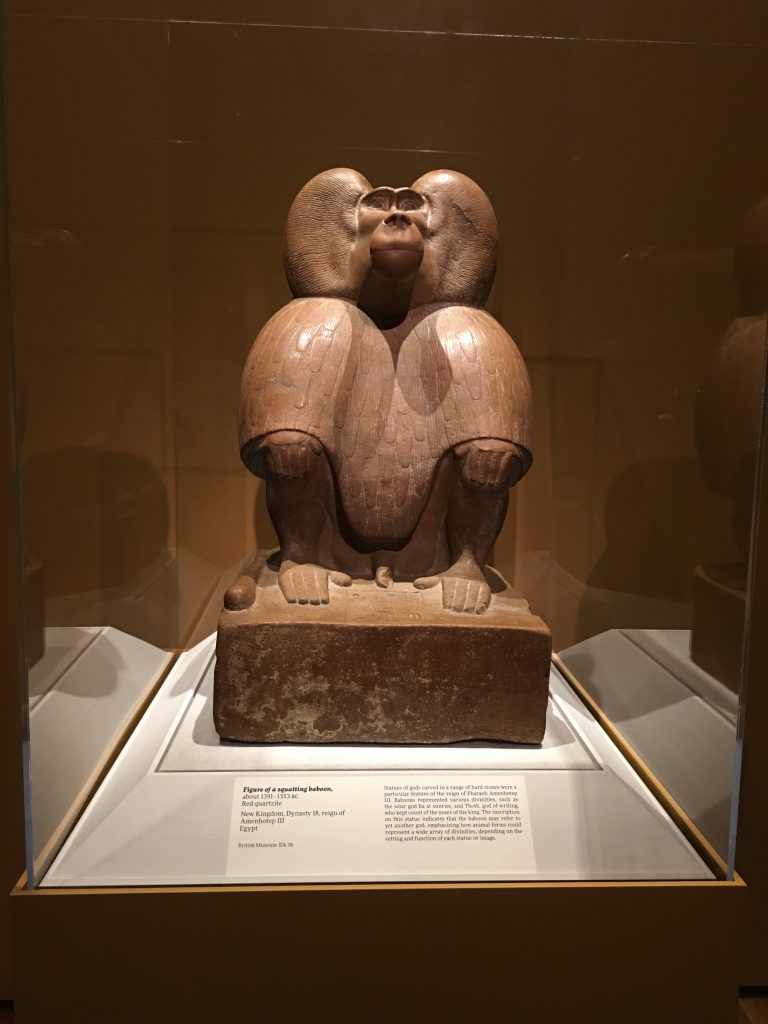
Figure of Squatting Baboon, about 1391 – 1353 BC
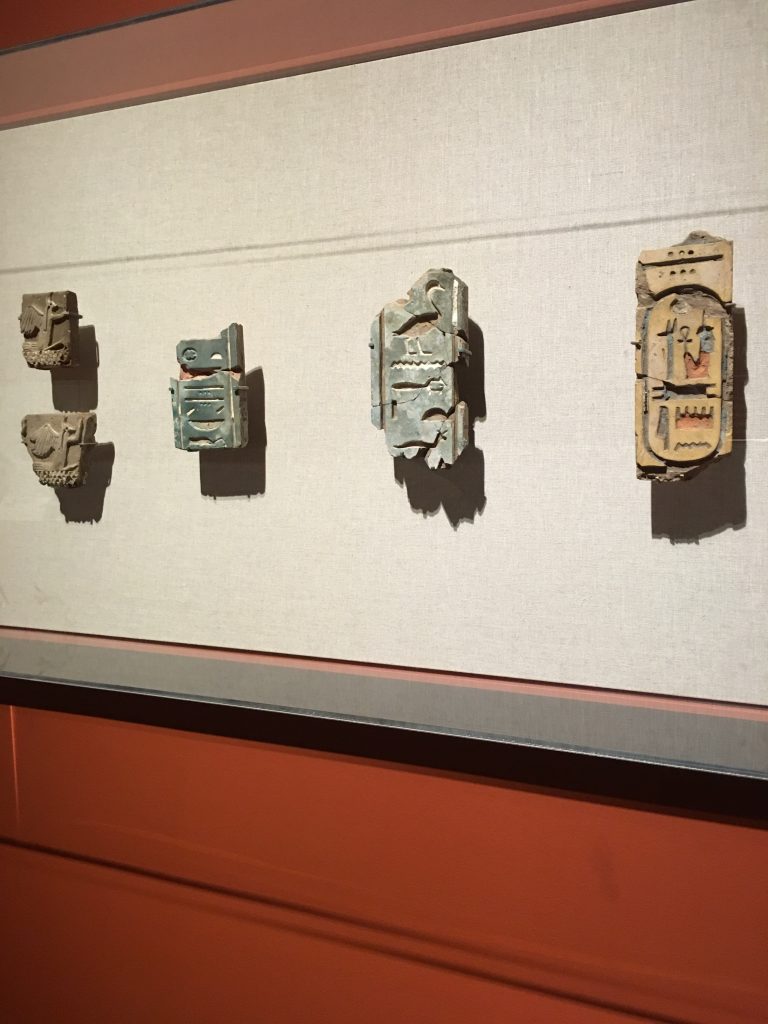
Tiles from the Palace of Pharaoh Ramses III, about 1184 – 1153 BC
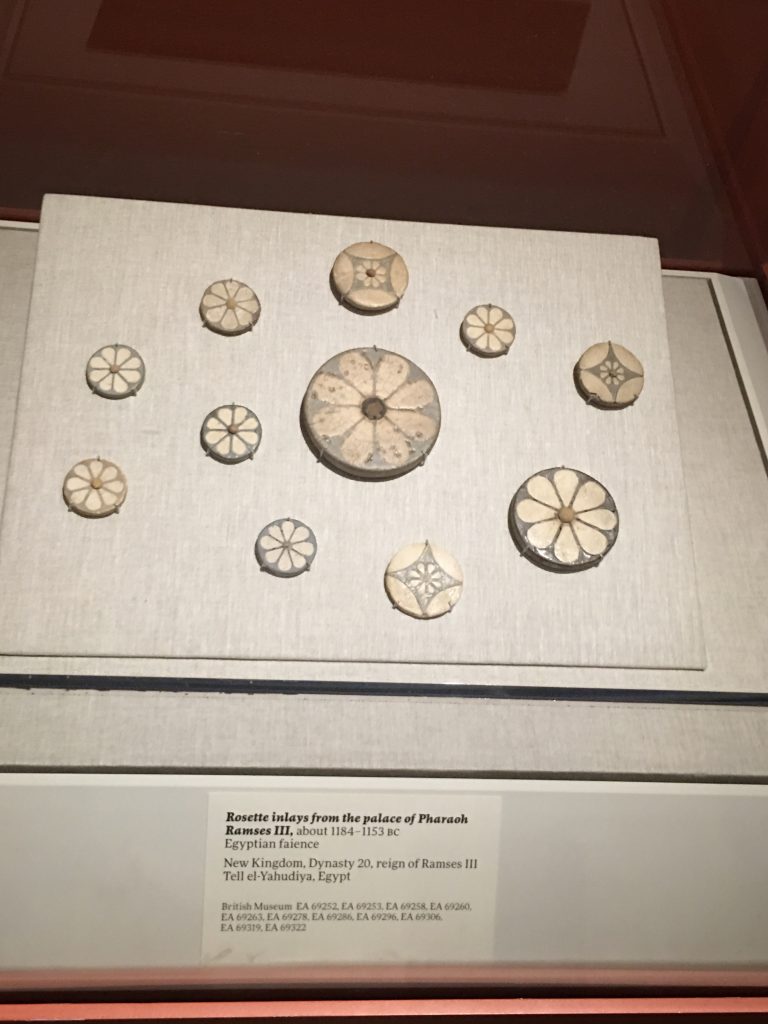
Rosette inlays from the Palace of Pharaoh Ramses III, about 1184 – 1153 BC
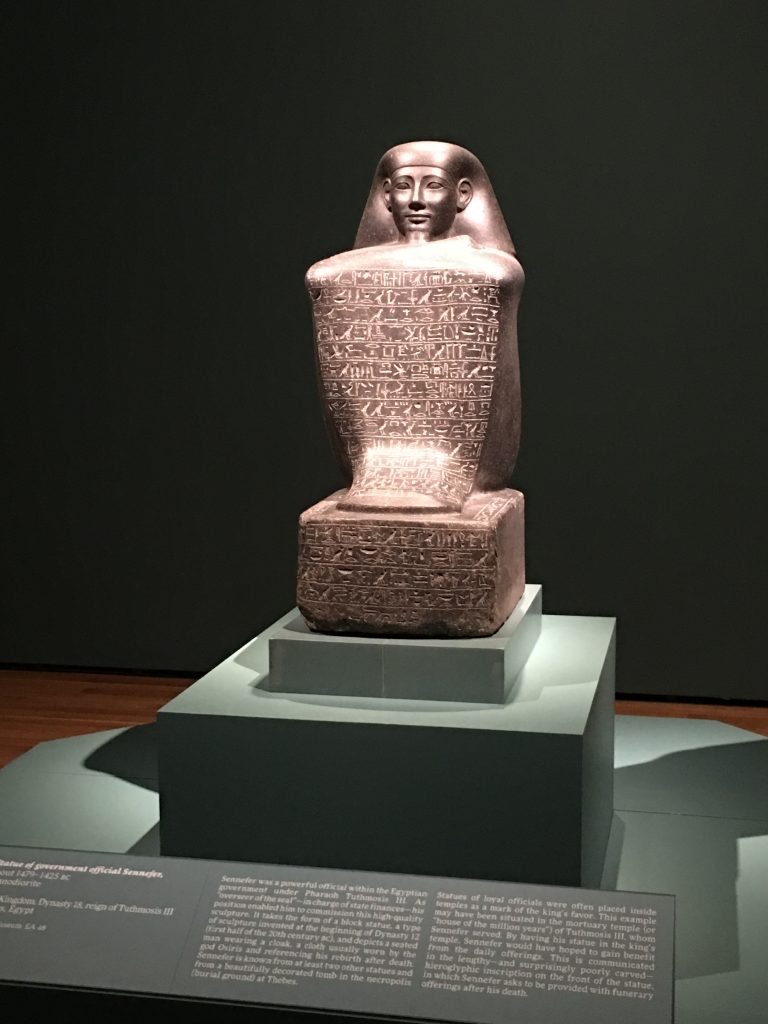
Statue of Government Official Sennefer, about 1479 – 1425 BC
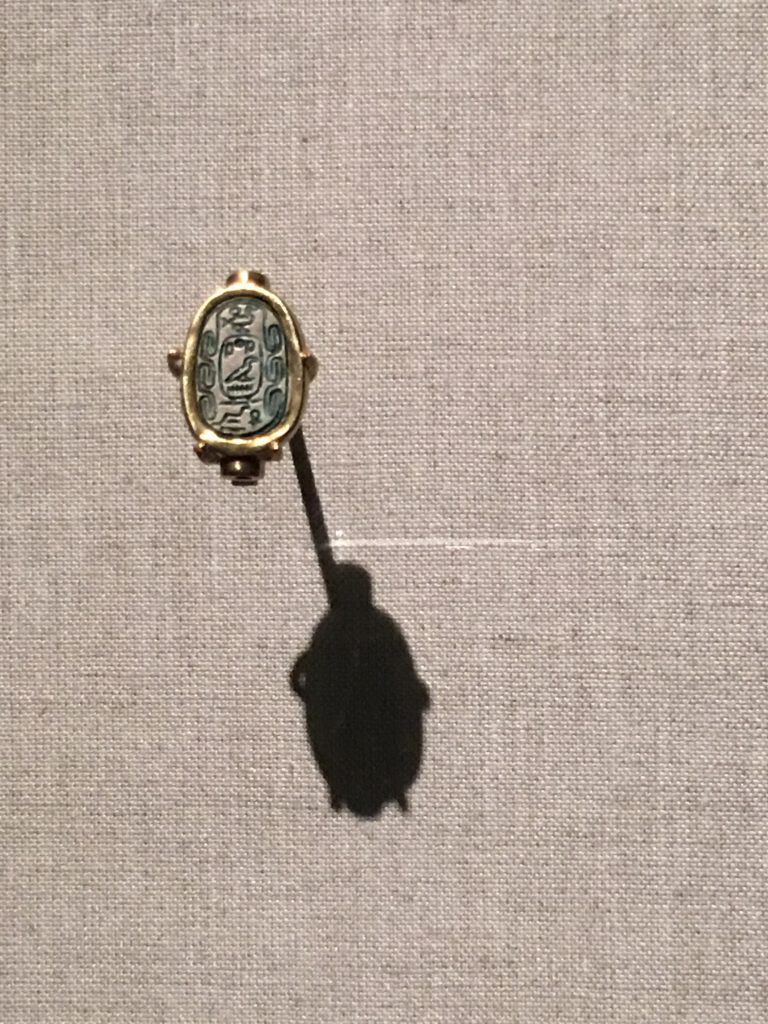
Scarab adorning a finger – ring, about 1648 – 1540 BC
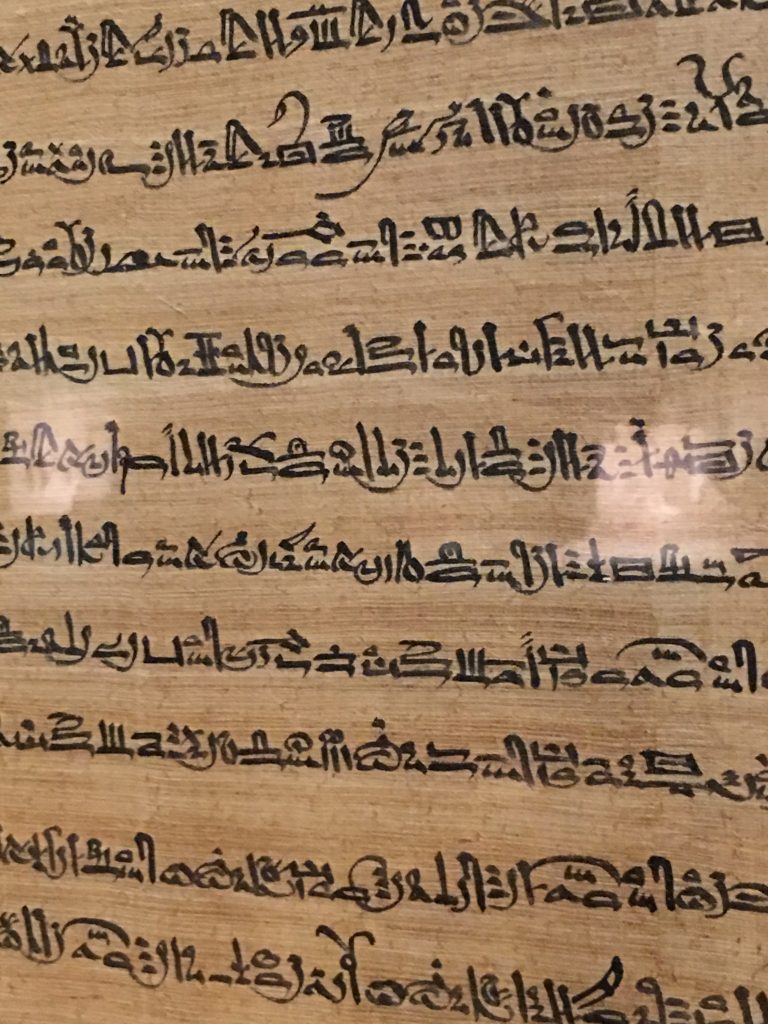
Great Harris Papyrus, about 1184 – 1153 BC
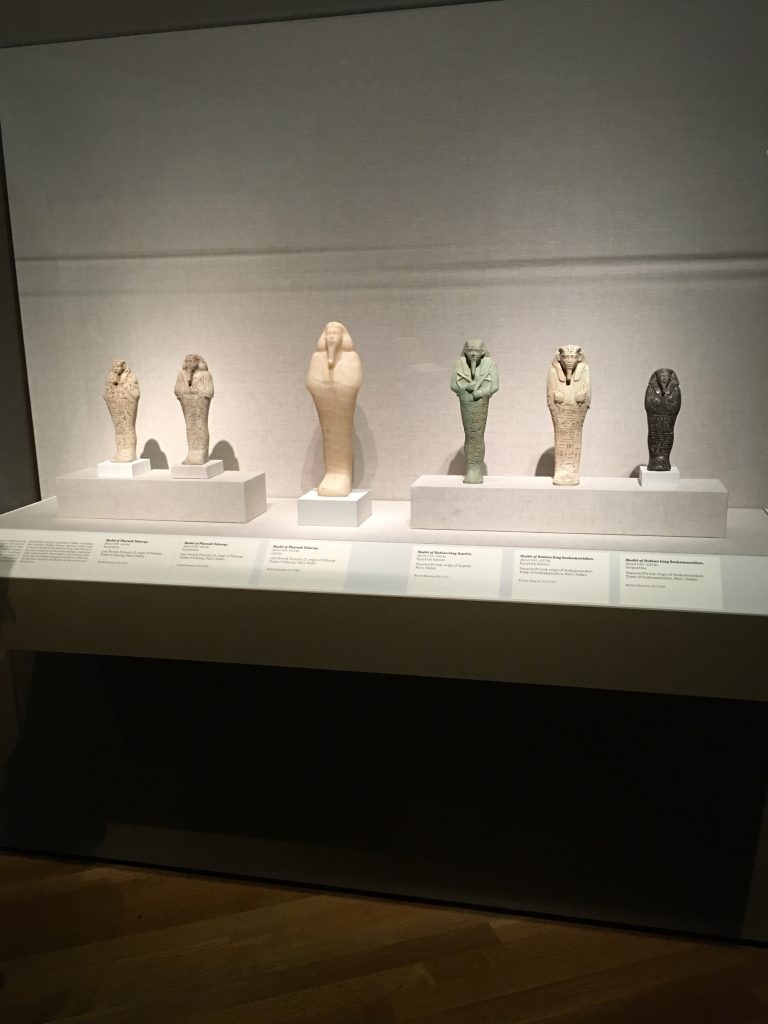
Shabtis of the many Pharaohs over the years
Disclosure: Please refer to our blog disclaimer tab for more information.